
Ficus is a genus of about 850 species of woody trees, shrubs, vines, epiphytes and hemiepiphytes in the family Moraceae. Collectively known as fig trees or figs, they are native throughout the tropics with a few species extending into the semi-warm temperate zone. The common fig (F. carica) is a temperate species native to southwest Asia and the Mediterranean region, which has been widely cultivated from ancient times for its fruit, also referred to as figs. The fruit of most other species are also edible though they are usually of only local economic importance or eaten as bushfood. However, they are extremely important food resources for wildlife. Figs are also of considerable cultural importance throughout the tropics, both as objects of worship and for their many practical uses.

Ficus macrophylla, commonly known as the Moreton Bay fig or Australian banyan, is a large evergreen banyan tree of the family Moraceae native to eastern Australia, from the Wide Bay–Burnett region in the north to the Illawarra in New South Wales, as well as Lord Howe Island. Its common name is derived from Moreton Bay in Queensland, Australia. It is best known for its imposing buttress roots.

Ficus elastica, the rubber fig, rubber bush, rubber tree, rubber plant, or Indian rubber bush, Indian rubber tree, is a species of flowering plant in the family Moraceae, native to eastern parts of South Asia and southeast Asia. It has become naturalized in Sri Lanka, the West Indies, and the US State of Florida.

Protea neriifolia, also known as the narrow-leaf sugarbush, oleander-leaved sugarbush, blue sugarbush, or the oleanderleaf protea, is a flowering plant in the genus Protea, which is endemic to South Africa.
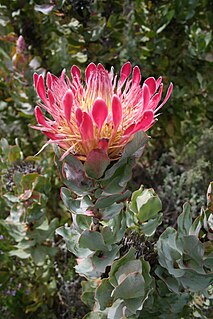
Protea eximia, the broad-leaved sugarbush, is a shrub from South Africa that may become a small tree. It occurs in mountain fynbos on mainly acidic sandy soils; the species was very well known under its old name of Protea latifolia. The flowers have awns that are covered in purple-black velvety hairs, and are contained within a series of rings of involucral bracts that have the appearance of petals. The fruit is a densely hairy nut, many of which are inserted on a woody base. The flowers are borne terminally on long shoots, and have a tendency to become very untidy as they age.
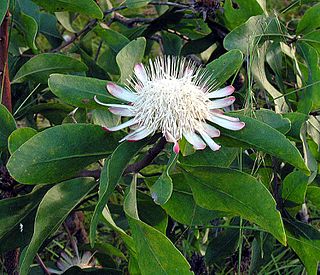
Protea gaguedi is a species of tree which belongs to the genus Protea.

Ficus obliqua, commonly known as the small-leaved fig, is a tree in the family Moraceae, native to eastern Australia, New Guinea, eastern Indonesia to Sulawesi and islands in the southwestern Pacific Ocean. Previously known for many years as Ficus eugenioides, it is a banyan of the genus Ficus, which contains around 750 species worldwide in warm climates, including the edible fig. Beginning life as a seedling, which grows on other plants (epiphyte) or on rocks (lithophyte), F. obliqua can grow to 60 m (200 ft) high and nearly as wide with a pale grey buttressed trunk, and glossy green leaves.

Celtis africana, the white stinkwood, is a deciduous tree in the family Cannabaceae. Its habit ranges from a tall tree in forest to a medium-sized tree in bushveld and open country, and a shrub on rocky soil. It occurs in Yemen and over large parts of Africa south of the Sahara. It is a common tree in the south and east of southern Africa, where the odour given off by freshly-cut green timber is similar to that of Ocotea bullata or Black Stinkwood.

Croton gratissimus, is a tropical African shrub or small tree with corky bark, growing to 8 m and belonging to the family of Euphorbiaceae or spurges. Young twigs are slender and angular and covered in silver and rust-coloured scales.

Ficus sur, with the common names Cape fig and broom cluster fig, is a widespread Afrotropical species of cauliflorous fig.

The Ficus sansibarica, known as knobbly fig, is an African species of cauliflorous fig. It is named after Zanzibar, where Franz Stuhlmann discovered it in 1889. They often begin life as epiphytes, which assume a strangling habit as they develop. They regularly reach 10 m, but may grow up to 40 m tall as forest stranglers.
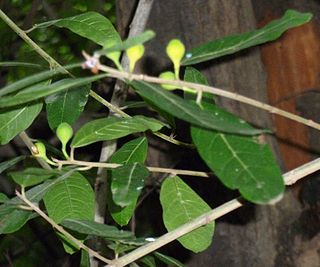
The river sandpaper fig is a fig shrub or small tree of the western and eastern Afrotropics. It is typically found around pans or flood plains, or along riparian fringes in tropical or subtropical savanna regions, but is absent from the tropical rainforest zone. Despite its regular scrambling habit it may attain a height of 7 to 10 m.

Ficus craterostoma, a species of strangler fig, is a fig shrub or tree of the Afrotropics that may grow up to 20 m tall. It is found in lowland tropical and swamp forests in the west, or in afromontane forests, including rocky situations, along Africa's eastern escarpments. The western and eastern populations may constitute separate species, as they occur at different altitudes where their ranges meet in central Africa, while they seem to have exclusive pollinating wasp species.
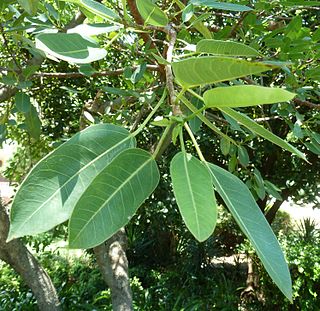
The Wonderboom is an evergreen fig species that ranges from the KwaZulu-Natal midlands northwards to tropical East Africa. It grows especially on outcrops, rocky hillsides and along cliffs fringing water courses and may rarely grow up to 10 m tall, and acquire a leafy spreading crown.

Ficus ingens, the red-leaved fig, is a fig species with an extensive range in the subtropical to dry tropical regions of Africa and southern Arabia. Despite its specific name, which means "huge", or "vast", it is usually a shrub or tree of modest proportions. It is a fig of variable habit depending on the local climate and substrate, typically a stunted subshrub on elevated rocky ridges, or potentially a large tree on warmer plains and lowlands. In 1829 the missionary Robert Moffat found a rare giant specimen, into which seventeen thatch huts of a native tribe were placed, so as to be out of reach of lions.

Ficus auriculata is a type of fig tree, native to Asia, noted for its big and round leaves. This is used as fodder in Nepal. It is least resistant to fire, but likes good sunlight.

Euclea crispa, commonly known as the blue guarri, is an Afrotropical plant species of the family Ebenaceae. The hardy and evergreen plants may form a dense stand of shrubs, or grow to tree size. It is widespread and common in the interior regions of southern Africa, and occurs northward to the tropics. Though some are present near the South African south and east coasts, they generally occur at middle to high altitudes. It is readily recognizable from its much-branched structure and dull bluish foliage colour. Those bearing lanceolate leaves may however resemble the Wild olive, another common species of the interior plateaus.
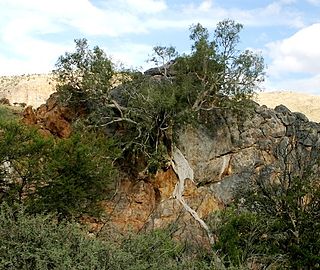
The Laurel fig is a species of rock-splitting fig that is native to the semi-desert regions of southwestern Africa. It is only found on rocks, up to an altitude of 1,300 m (4,300 ft).

Ficus polita, the heart-leaved fig, is a species of fig that is native to forests of tropical Africa,
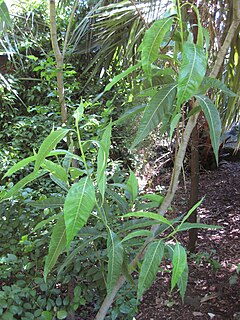
Ficus coronulata, commonly known as the peach-leaf fig, and in the Northern Territory as river fig and crown fig, is one of several fig species commonly known as sandpaper figs. It is native to Western Australia and the Northern Territory.






















